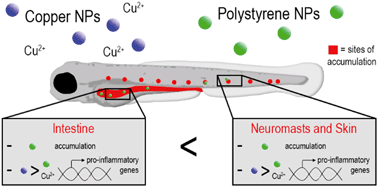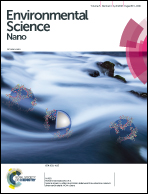Nanoparticles induce dermal and intestinal innate immune system responses in zebrafish embryos†
Abstract
Major molecular mechanisms that underpin the toxicity of nanoparticles (NPs) are the formation of reactive oxygen species and the induction of inflammation. The latter is frequently observed in vitro and in mammalian organisms, yet in aquatic organisms, such NP-induced inflammatory responses remain largely unexplored. Zebrafish offer a wide range of molecular tools to investigate immune responses in an aquatic organism, and were therefore used here to describe how copper (Cu) NPs (25 nm; 1 mg L−1) and soluble Cu as well as polystyrene (PS) NPs (25 nm; 10 mg L1−) induce innate immune responses, focussing on the skin cells and the intestine as likely organs of interaction. mRNA expression of the immune responsive genes interleukin 1 beta (il1β) and immunoresponsive gene 1-like (irg1l) of CuNP exposed embryos was observed to be weaker in the intestinal tissue compared to the rest of the body, indicating a strong outer epithelium response. Specifically, NPs were observed to accumulate in the cavities of lateral neuromasts in the skin, which coincided with an increased local expression of il1β. Exposure to CuNPs triggered the strongest transcriptional changes in pro-inflammatory-related genes and was also observed to increase migration of neutrophils in the tail, indicating a NP-specific inflammatory response. This is the first in vivo evidence for waterborne NP exposure triggering alterations of immune system regulating genes in the skin and intestine of zebrafish embryos. The observed molecular responses have the potential to be linked to adverse effects at higher levels of biological organization and hence might be used for screening purposes in nanotoxicology or as building blocks for adverse outcome pathways.

- This article is part of the themed collection: ICEENN


 Please wait while we load your content...
Please wait while we load your content...